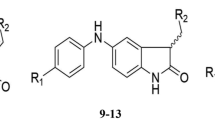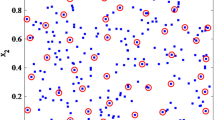Abstract
In cancer disease, which is one of the problems of today’s human societies, the expression of some tyrosine kinase receptors that are effective in the growth and proliferation of cancerous cells rises. Therefore, it is essential to develop and propose new drugs to target the receptors. Performing modeling calculations such as QSAR and docking makes the drug discovery process more efficient. Thus, backpropagation artificial neural network was used for multidimensional quantitative structure–activity relationship (QSAR) to identify essential features of pyrazolopyrimidine moiety, responsible for anticancer activity. The statistical parameters of the model show that multi-QSAR has sufficient validity and accuracy. According to the QSAR modeling, among 26 compounds, the interaction of eight candidates with EGFR, FGFR4, PDGFRA, and VEGFR2 was analyzed by docking modeling. The results showed that 1u compound binds to proteins in a more appropriate area (except FGFR4) with acceptable energy. The results of docking for VEGFR2 binding showed that 1u binds to the active site and binding site of receptor, and it was in the interaction with ten residues in the sites. Although the binding site of 1u molecule in the FGFR4 was not suitable, the binding free energy was excellent (− 9.22 kcal mol−1), which was less than those two anticancer drugs of gefitinib and regorafenib. Furthermore, the values of binding free energy were − 8.69, − 9.64, and − 9.19 kcal mol−1 for EGFR, PDGFRA, and VEGFR2, respectively. Therefore, this study introduces 1u as an anticancer agent that can inhibit the tyrosine kinase receptors.
Graphic abstract








Similar content being viewed by others
References
Siegel RL, Miller KD (2018) Jemal A (2018) Cancer statistics. CA Cancer J Clin 68(1):7–30
Dorai T, Aggarwal BB (2004) Role of chemopreventive agents in cancer therapy. Cancer Lett 215(2):129–140
Arora A, Scholar EM (2005) Role of tyrosine kinase inhibitors in cancer therapy. J Pharmacol Exp Ther 315(3):971–979
Li E, Hristova K (2010) Receptor tyrosine kinase transmembrane domains: Function, dimer structure and dimerization energetics. Cell Adh Migr 4(2):249–254
Bahmani A, Saaidpour S, Rostami A (2017) A simple, robust and efficient computational method for n-octanol/water partition coefficients of substituted aromatic drugs. Sci Rep 7:5760–5774
Slynko I, Scharfe M, Rumpf T, Eib J, Metzger E, Schüle R, Jung M, Sippl W (2014) Virtual screening of PRK1 inhibitors: ensemble docking, rescoring using binding free energy calculation and QSAR model development. J Chem Inf Model 54:138–150
Chaube U, Chhatbar D, Bhatt H (2016) 3D-QSAR, molecular dynamics simulations and molecular docking studies of benzoxazepine moiety as mTOR inhibitor for the treatment of lung cancer. Bioorg Med Chem Lett 26(3):864–874
Dong H, Liu J, Liu X, Yu Y, Cao S (2018) Combining molecular docking and QSAR studies for modeling the anti-tyrosinase activity of aromatic heterocycle thiosemicarbazone. J Mol Struct 1151:353–365
Masand VH, El-Sayed NNE, Bambole MU, Quazi SA (2018) Multiple QSAR models, pharmacophore pattern and molecular docking analysis for anticancer activity of α, β-unsaturated carbonyl-based compounds, oxime and oxime ether analogs. J Mol Struct 1157:89–96
Engel J, Smith S, Lategahn J, Tumbrink HL, Goebel L, Becker C, Hennes E, Keul M, Unger A, Müller H, Baumann M, Schultz-Fademrecht C, Günther G, Hengstler JG, Rauh D (2017) Structure-guided development of covalent and mutant-selective pyrazolopyrimidines to target T790M drug resistance in epidermal growth factor receptor. J Med Chem 60(18):7725–7744
Xu L, Zhang WJ (2001) Comparison of different methods for variable selection. Anal Chim Acta 446:477–483
Bahmani A, Saaidpour S, Rostami A (2017) Quantitative structure–retention relationship modeling of morphine and its derivatives on OV-1 column in gas–liquid chromatography using genetic algorithm. Chromatographia 80(4):629–636
Hosseinpour Moghadam N, Salehzadeh S, Shahabadi N, Golbedaghi R (2017) A multi-spectroscopic and molecular docking approach to investigate the interaction of antiviral drug oseltamivir with ct-DNA. Nucleosides Nucleotides Nucleic Acids 36(7):435–451. https://doi.org/10.1080/15257770.2017.1287379
Salehzadeh S, Hajibabaei F, Hosseinpour Moghadam N, Sharifinia S, Khazalpour S, Golbedaghi R (2018) Binding studies of isoxsuprine hydrochloride to calf thymus DNA using multispectroscopic and molecular docking techniques. J Fluoresc 28(1):195–206
Tanzadehpanah H, Asoodeh A, Saidijam M, Chamani J, Mahaki H (2017) Improving efficiency of an angiotensin converting enzyme inhibitory peptide as multifunctional peptides. J Biomol Struct Dyn, 1–16
Cheng CT, Zhao MY, Chau KW, Wu XY (2006) Using genetic algorithm and TOPSIS for Xinanjiang model calibration with a single procedure. J Hydrol 316:129–140
Head RD, Smythe ML, Oprea TI, Waller CL, Green SM, Marshall GR (1996) VALIDATE: a new method for the receptor-based prediction of binding affinities of novel ligands. J Am Chem Soc 118(16):3959–3969
Lipkus AH (2001) Exploring chemical rings in a simple topological-descriptor space. J Chem Inf Model 41(2):430–438
Consonni V, Todeschini R, Pavan M (2002) Structure/response correlations and similarity/diversity analysis by GETAWAY descriptors 1 theory of the novel 3D molecular descriptors. J Chem Inf Model 42(3):682–692
Deshpande S, Solomon VR, Katti SB, Prabhakar YS (2009) Topological descriptors in modelling antimalarial activity: N1-(7-chloro-4-quinolyl)-1,4-bis(3-aminopropyl)piperazine as prototype. J Enzyme Inhib Med Chem 24(1):94–104
Todeschini R, Consonni V (2003) Descriptors from molecular geometry in Handbook of Chemoinformatics, vol 3. Wiley-VCH Verlag GmbH, Weinheim, Germany
Ritchie TJ, Macdonald SJF (2014) Physicochemical descriptors of aromatic character and their use in drug discovery. J Med Chem 57(17):7206–7215
Todeschini R, Consonni V (2000) Handbook of molecular descriptors. Wiley-VCH Verlag GmbH, Weinheim, Germany
Devinyak O, Havrylyuk D, Lesyk R (2014) 3D-MoRSE descriptors explained. J Mol Graph Model 54:194–203
Roskoski R Jr (2014) The ErbB/HER family of protein-tyrosine kinases and cancer. Pharmacol Res 79:34–74
Xu G, Searle LL, Hughes TV, Beck AK, Connolly PJ, Abad MC, Neeper MP, Struble GT, Springer BA, Emanuel SL (2008) Discovery of novel 4-amino-6-arylaminopyrimidine-5-carbaldehyde oximes as dual inhibitors of EGFR and ErbB-2 protein tyrosine kinases. Bioorg Med Chem Lett 18(12):3495–3499
Yewale C, Baradia D, Vhora I, Patil S, Misra A (2013) Epidermal growth factor receptor targeting in cancer: a review of trends and strategies. Biomaterials 34(34):8690–8707
Tanzadehpanah H, Mahaki H, Hosseinpour Moghadam N, Salehzadeh S, Rajabi O, Najafi R, Amini R, Saidijam M (2018) Binding site identification of anticancer drug gefitinib to HSA and DNA in the presence of five different probes. J Biomol Struct Dyn 1–14
Zhang X, Gureasko J, Shen K, Cole PA, Kuriyan J (2006) An allosteric mechanism for activation of the kinase domain of epidermal growth factor receptor. Cell 125(6):1137–1149
Aertgeerts K, Skene R, Yano J, Sang BC, Zou H, Snell G, Jennings A, Iwamoto K, Habuka N, Hirokawa A (2011) Structural analysis of the mechanism of inhibition and allosteric activation of the kinase domain of HER2 protein. J Biol Chem 286(21):18756–18765
Gupta AK, Bhunia SS, Balaramnavar VM, Saxena AK (2011) Pharmacophore modelling, molecular docking and virtual screening for EGFR (HER 1) tyrosine kinase inhibitors. SAR QSAR Environ Res 22(3–4):239–263
Noolvi MN, Patel HM (2013) A comparative QSAR analysis and molecular docking studies of quinazoline derivatives as tyrosine kinase (EGFR) inhibitors: A rational approach to anticancer drug design. J Saudi Chem Soc 17(4):361–379
Yun CH, Boggon TJ, Li Y, Woo MS, Greulich H, Meyerson M, Eck MJ (2007) Structures of lung cancer-derived EGFR mutants and inhibitor complexes: mechanism of activation and insights into differential inhibitor sensitivity. Cancer Cell 11(3):217–227
Ho HK, Yeo AHL, Kang TS, Chua BT (2014) Current strategies for inhibiting FGFR activities in clinical applications: opportunities, challenges and toxicological considerations. Drug Discov Today 19(1):51–62
Cheng W, Wang M, Tian X, Zhang X (2017) An overview of the binding models of FGFR tyrosine kinases in complex with small molecule inhibitors. Eur J Med Chem 126:476–490
Ho HK, Németh G, Ng YR, Pang E, Szantai-Kis C, Zsákai L, Breza N, Greff Z, Horvath Z, Pato J (2013) Developing FGFR4 inhibitors as potential anti-cancer agents via in silico design, supported by in vitro and cell-based testing. Curr Med Chem 20(10):1203–1217
Mo C, Zhang Z, Guise CP, Li X, Luo J, Tu Z, Xu Y, Patterson AV, Smaill JB, Ren X (2017) 2-Aminopyrimidine derivatives as new selective fibroblast growth factor receptor 4 (FGFR4) inhibitors. ACS Med Chem Lett 8(5):543–548
Liang L, Yan XE, Yin Y, Yun CH (2016) Structural and biochemical studies of the PDGFRA kinase domain. Biochem Biophys Res Commun 477(4):667–672
Hasegawa M, Nishigaki N, Washio Y, Kano K, Harris PA, Sato H, Mori I, West RI, Shibahara M, Toyoda H (2007) Discovery of novel benzimidazoles as potent inhibitors of TIE-2 and VEGFR-2 tyrosine kinase receptors. J Med Chem 50(18):4453–4470
Ugale VG, Patel HM, Surana SJ (2017) Molecular modeling studies of quinoline derivatives as VEGFR-2 tyrosine kinase inhibitors using pharmacophore based 3D QSAR and docking approach. Arab J Chem 10:S1980–S2003
Munoz C, Adasme F, Alzate-Morales JH, Vergara-Jaque A, Kniess T, Caballero J (2012) Study of differences in the VEGFR2 inhibitory activities between semaxanib and SU5205 using 3D-QSAR, docking, and molecular dynamics simulations. J Mol Graph Model 32:39–48
Acknowledgements
The authors would like to acknowledge the Research Center for Molecular Medicine, Hamadan University of Medical Sciences, Hamadan, Iran.
Funding
This work is a part of the research project and was financially supported by Deputy of Research, Hamadan University of Medical Sciences [Grant Number 9612158167]. Therefore, the authors are very thankful for the support of this deputy.
Author information
Authors and Affiliations
Contributions
In this work, the authors had various responsibilities. A. Bahmani was responsible for proposing the project, doing QSAR-modeling, interpretation of QSAR, and writing QSAR for articles. N. Hosseinpour Moghadam was responsible for docking calculations. H. Tanzadehpanah was responsible for interpreting and writing of docking for the article. M. Saidijam led the research team and was responsible for editing and submitting the article to the journal.
Corresponding author
Ethics declarations
Conflict of interest
The authors declare that they have no conflict of interest.
Ethical approval
This article does not contain any studies with human participants or animals performed by any of the authors.
Rights and permissions
About this article
Cite this article
Bahmani, A., Tanzadehpanah, H., Hosseinpour Moghadam, N. et al. Introducing a pyrazolopyrimidine as a multi-tyrosine kinase inhibitor, using multi-QSAR and docking methods. Mol Divers 25, 949–965 (2021). https://doi.org/10.1007/s11030-020-10080-8
Received:
Accepted:
Published:
Issue Date:
DOI: https://doi.org/10.1007/s11030-020-10080-8




